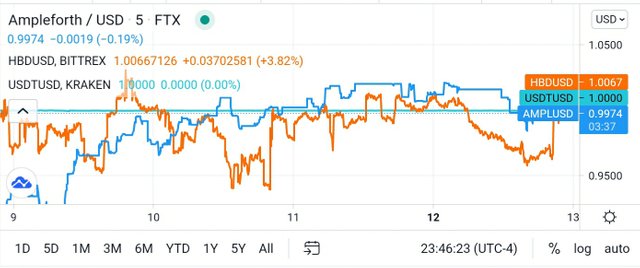Stability Of Algorithmic Stablecoin - AMPL Vs HBD
Stablecoins are cryptocurrencies that have a stable value against legal tender, usually against the US dollar. The goal is to enable business actors to use them as a reliable price measurement tool.
Imagine if you were to price an item or service using bitcoin, whose price fluctuates very much or changes very rapidly. Then, as soon as the price of bitcoin changes, the price of the item or service will also change.
Among the different types of stablecoins, the most stable are those that use collateral in the form of legal tender or other cryptocurrencies. Examples include Tether (USDT), whose collateral is USD, or Dai (DAI), which uses Ethereum collateral.
On the other hand, the most difficult stablecoins to create are those that use algorithms to stabilize their prices without collateral - the so-called algorithmic stablecoins. Examples include Ampleforth (AMPL), Fei Protocol (FEI), and HIVE Backed Dollar (HBD).
Because they do not use collateral, algorithmic stablecoins can be highly scalable to keep pace with economic development and highly decentralized to avoid power concentration.
Ampleforth (AMPL) is one of the algorithmic stablecoins that pegs its price to the US dollar. It uses an algorithm called elastic supply to stabilize the price.
When the price drops below $1, Ampleforth will dynamically reduce its supply, and proportionally all users will notice that the number of coins in their wallets has decreased. This reduction in the amount of coins in circulation will cause the price to rise towards $1 again.
On the other hand, when the price goes above $1, Ampleforth will increase the supply and all users will find themselves with more coins in their wallets. As the circulation of this coin increases, the price will drop again towards $1.
HBD (HIVE Backed Dollar), on the other hand, is an algorithmic stablecoin backed by HIVE coin, a pair of native coins on the Hive blockchain. HBD has officially been a stablecoin since the last Hive hardfork about a week ago.
Basically, HBD is a smart contract on the Hive blockchain that ensures that a user can convert 1 HBD for 1 USD amount of HIVE at any time, and vice versa.
Thus, when the price of HBD falls below $1, the user can convert it for $1 worth of HIVE in the blockchain, use that HIVE to buy another cheaper HBD, and then convert it again in the blockchain and so on. This puts buying pressure on HBDs in the market, driving the price back up to $1.
On the other hand, if the price of HBD exceeds $1, users can convert $1 worth of HIVE for 1 HBD, use the expensive HBD to buy another HIVE, and then convert it again and so on. This puts selling pressure on the HBDs in the market, and lowering the price back to $1.
The chart above shows the prices of the three stablecoins over the past five days in US dollars. That is, prices of USDT that based on collateral, and AMPL and HBD that based on algorithm.
USDT with USD collateral is the most stable and can be used as a benchmark for the other two. That is, AMPL and HBD that are algorithm-based and have no collateral.
We can see that the prices of the two algorithmic stablecoins fluctuated between $0.95 and $1.05. However, HBD was mostly below $1.00, while AMPL was well above $1.00, but sometimes below $0.95 too.
This fluctuation is sufficiently large to be called a true stablecoin. Fluctuations of this magnitude make the prices of goods and services volatile. This makes it difficult for business actors to run their businesses.
There is still a lot of homework to be done by the algorithmic stablecoin development team. What are the ways to control these fluctuations and improve the precision of stability? So that in the future the algorithmic stablecoins can actually become real stablecoins.
See also:
